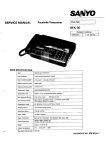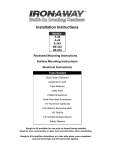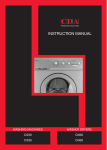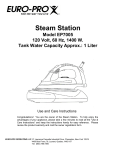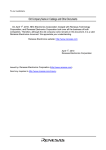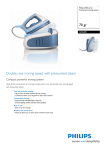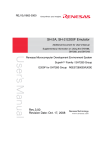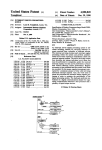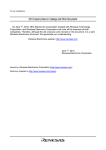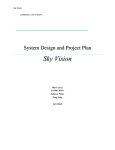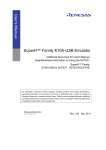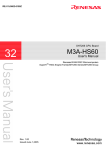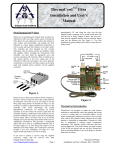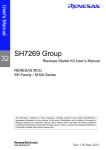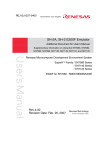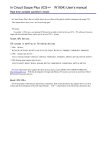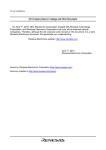Download Renesas Starter Kit2+ for SH7216 User`s Manual
Transcript
To our customers, Old Company Name in Catalogs and Other Documents On April 1st, 2010, NEC Electronics Corporation merged with Renesas Technology Corporation, and Renesas Electronics Corporation took over all the business of both companies. Therefore, although the old company name remains in this document, it is a valid Renesas Electronics document. We appreciate your understanding. Renesas Electronics website: http://www.renesas.com April 1st, 2010 Renesas Electronics Corporation Issued by: Renesas Electronics Corporation (http://www.renesas.com) Send any inquiries to http://www.renesas.com/inquiry. Notice 1. 2. 3. 4. 5. 6. 7. All information included in this document is current as of the date this document is issued. Such information, however, is subject to change without any prior notice. Before purchasing or using any Renesas Electronics products listed herein, please confirm the latest product information with a Renesas Electronics sales office. Also, please pay regular and careful attention to additional and different information to be disclosed by Renesas Electronics such as that disclosed through our website. Renesas Electronics does not assume any liability for infringement of patents, copyrights, or other intellectual property rights of third parties by or arising from the use of Renesas Electronics products or technical information described in this document. No license, express, implied or otherwise, is granted hereby under any patents, copyrights or other intellectual property rights of Renesas Electronics or others. You should not alter, modify, copy, or otherwise misappropriate any Renesas Electronics product, whether in whole or in part. Descriptions of circuits, software and other related information in this document are provided only to illustrate the operation of semiconductor products and application examples. You are fully responsible for the incorporation of these circuits, software, and information in the design of your equipment. Renesas Electronics assumes no responsibility for any losses incurred by you or third parties arising from the use of these circuits, software, or information. When exporting the products or technology described in this document, you should comply with the applicable export control laws and regulations and follow the procedures required by such laws and regulations. You should not use Renesas Electronics products or the technology described in this document for any purpose relating to military applications or use by the military, including but not limited to the development of weapons of mass destruction. Renesas Electronics products and technology may not be used for or incorporated into any products or systems whose manufacture, use, or sale is prohibited under any applicable domestic or foreign laws or regulations. Renesas Electronics has used reasonable care in preparing the information included in this document, but Renesas Electronics does not warrant that such information is error free. Renesas Electronics assumes no liability whatsoever for any damages incurred by you resulting from errors in or omissions from the information included herein. Renesas Electronics products are classified according to the following three quality grades: “Standard”, “High Quality”, and “Specific”. The recommended applications for each Renesas Electronics product depends on the product’s quality grade, as indicated below. You must check the quality grade of each Renesas Electronics product before using it in a particular application. You may not use any Renesas Electronics product for any application categorized as “Specific” without the prior written consent of Renesas Electronics. Further, you may not use any Renesas Electronics product for any application for which it is not intended without the prior written consent of Renesas Electronics. Renesas Electronics shall not be in any way liable for any damages or losses incurred by you or third parties arising from the use of any Renesas Electronics product for an application categorized as “Specific” or for which the product is not intended where you have failed to obtain the prior written consent of Renesas Electronics. The quality grade of each Renesas Electronics product is “Standard” unless otherwise expressly specified in a Renesas Electronics data sheets or data books, etc. “Standard”: 8. 9. 10. 11. 12. Computers; office equipment; communications equipment; test and measurement equipment; audio and visual equipment; home electronic appliances; machine tools; personal electronic equipment; and industrial robots. “High Quality”: Transportation equipment (automobiles, trains, ships, etc.); traffic control systems; anti-disaster systems; anticrime systems; safety equipment; and medical equipment not specifically designed for life support. “Specific”: Aircraft; aerospace equipment; submersible repeaters; nuclear reactor control systems; medical equipment or systems for life support (e.g. artificial life support devices or systems), surgical implantations, or healthcare intervention (e.g. excision, etc.), and any other applications or purposes that pose a direct threat to human life. You should use the Renesas Electronics products described in this document within the range specified by Renesas Electronics, especially with respect to the maximum rating, operating supply voltage range, movement power voltage range, heat radiation characteristics, installation and other product characteristics. Renesas Electronics shall have no liability for malfunctions or damages arising out of the use of Renesas Electronics products beyond such specified ranges. Although Renesas Electronics endeavors to improve the quality and reliability of its products, semiconductor products have specific characteristics such as the occurrence of failure at a certain rate and malfunctions under certain use conditions. Further, Renesas Electronics products are not subject to radiation resistance design. Please be sure to implement safety measures to guard them against the possibility of physical injury, and injury or damage caused by fire in the event of the failure of a Renesas Electronics product, such as safety design for hardware and software including but not limited to redundancy, fire control and malfunction prevention, appropriate treatment for aging degradation or any other appropriate measures. Because the evaluation of microcomputer software alone is very difficult, please evaluate the safety of the final products or system manufactured by you. Please contact a Renesas Electronics sales office for details as to environmental matters such as the environmental compatibility of each Renesas Electronics product. Please use Renesas Electronics products in compliance with all applicable laws and regulations that regulate the inclusion or use of controlled substances, including without limitation, the EU RoHS Directive. Renesas Electronics assumes no liability for damages or losses occurring as a result of your noncompliance with applicable laws and regulations. This document may not be reproduced or duplicated, in any form, in whole or in part, without prior written consent of Renesas Electronics. Please contact a Renesas Electronics sales office if you have any questions regarding the information contained in this document or Renesas Electronics products, or if you have any other inquiries. (Note 1) “Renesas Electronics” as used in this document means Renesas Electronics Corporation and also includes its majorityowned subsidiaries. (Note 2) “Renesas Electronics product(s)” means any product developed or manufactured by or for Renesas Electronics. Renesas Starter Kit2+ for SH7216 User's Manual Renesas 32-Bit RISC Microcomputer SuperHTM RISC engine family Rev.1.00 2010.01 Disclaimer By using this Renesas Starter Kit (RSK), the user accepts the following terms. The RSK is not guaranteed to be error free, and the entire risk as to the results and performance of the RSK is assumed by the User. The RSK is provided by Renesas on an “as is” basis without warranty of any kind whether express or implied, including but not limited to the implied warranties of satisfactory quality, fitness for a particular purpose, title and non-infringement of intellectual property rights with regard to the RSK. Renesas expressly disclaims all such warranties. Renesas or its affiliates shall in no event be liable for any loss of profit, loss of data, loss of contract, loss of business, damage to reputation or goodwill, any economic loss, any reprogramming or recall costs (whether the foregoing losses are direct or indirect) nor shall Renesas or its affiliates be liable for any other direct or indirect special, incidental or consequential damages arising out of or in relation to the use of this RSK, even if Renesas or its affiliates have been advised of the possibility of such damages. Precautions This Renesas Starter Kit is only intended for use in a laboratory environment under ambient temperature and humidity conditions. A safe separation distance should be used between this and any sensitive equipment. Its use outside the laboratory, classroom, study area or similar such area invalidates conformity with the protection requirements of the Electromagnetic Compatibility Directive and could lead to prosecution. The product generates, uses, and can radiate radio frequency energy and may cause harmful interference to radio communications. However, there is no guarantee that interference will not occur in a particular installation. If this equipment causes harmful interference to radio or television reception, which can be determined by turning the equipment off or on, you are encouraged to try to correct the interference by one or more of the following measures; • ensure attached cables do not lie across the equipment • reorient the receiving antenna • increase the distance between the equipment and the receiver • connect the equipment into an outlet on a circuit different from that which the receiver is connected • power down the equipment when not is use • consult the dealer or an experienced radio/TV technician for help NOTE: It is recommended that wherever possible shielded interface cables are used. The product is potentially susceptible to certain EMC phenomena. To mitigate against them it is recommended that the following measures be undertaken; • The user is advised that mobile phones should not be used within 10m of the product when in use. • The user is advised to take ESD precautions when handling the equipment. The Renesas Starter Kit does not represent an ideal reference design for an end product and does not fulfil the regulatory standards for an end product. ii Table of Contents Chapter 1. Preface .................................................................................................................................................. 1 Chapter 2. Purpose ................................................................................................................................................. 2 Chapter 3. Power Supply ........................................................................................................................................ 3 3.1. Requirements ............................................................................................................................................... 3 3.2. Power – Up Behaviour ................................................................................................................................. 3 Chapter 4. Board Layout ......................................................................................................................................... 4 4.1. Component Layout ....................................................................................................................................... 4 4.2. Board Dimensions ........................................................................................................................................ 5 Chapter 5. Block Diagram ....................................................................................................................................... 6 Chapter 6. User Circuitry......................................................................................................................................... 7 6.1. Switches ....................................................................................................................................................... 7 6.2. LEDs ............................................................................................................................................................. 8 6.3. Potentiometer ............................................................................................................................................... 8 6.4. Serial port ..................................................................................................................................................... 9 6.5. RCAN ........................................................................................................................................................... 9 6.6. USB .............................................................................................................................................................. 9 6.7. Ethernet ...................................................................................................................................................... 10 6.8. Debug LCD Module .................................................................................................................................... 11 6.9. Option Links and Jumper Settings ............................................................................................................. 12 6.10. Oscillator Sources .................................................................................................................................... 18 6.11. Reset Circuit ............................................................................................................................................. 18 Chapter 7. Modes.................................................................................................................................................. 19 Chapter 8. Programming Methods ........................................................................................................................ 20 Chapter 9. Headers ............................................................................................................................................... 21 9.1. Extension Headers ..................................................................................................................................... 21 Chapter 10. Code Development ........................................................................................................................... 25 10.1. Overview................................................................................................................................................... 25 10.2. Compiler Restrictions ............................................................................................................................... 25 10.3. Breakpoint Support ................................................................................................................................... 25 10.4. Memory Map............................................................................................................................................. 26 Chapter 11. Component Placement ...................................................................................................................... 27 Chapter 12. Additional Information........................................................................................................................ 28 iii Chapter 1. Preface Cautions This document may be, wholly or partially, subject to change without notice. All rights reserved. Duplication of this document, either in whole or part is prohibited without the written permission of Renesas Technology Europe Limited. Trademarks All brand or product names used in this manual are trademarks or registered trademarks of their respective companies or organisations. Copyright © 2010 Renesas Technology Europe Ltd. All rights reserved. © 2010 Renesas Technology Corporation. All rights reserved. © 2010 Renesas Solutions Corporation. All rights reserved. Website: http://www.eu.renesas.com/ Glossary ADC Analog to Digital Converter LED Light Emitting Diode CPU Central Processing Unit MCU Microcontroller Unit DAC Digital to Analog Converter NC No Connection E10A ‘E10A for Starter Kits’ Debugger PC Program Counter EMC Electromagnetic compatibility RAM Random Access Memory ESD Electrostatic Discharge RCAN Renesas Controller Area Network HEW High-performance Embedded Workshop ROM Read-Only Memory I/O Input / Output RSK Renesas Starter Kit LCD Liquid Crystal Display SDRAM Synchronous Memory 1 Dynamic Random Access Chapter 2. Purpose This RSK is an evaluation tool for Renesas microcontrollers. Features include: • Renesas Microcontroller Programming. • User Code Debugging. • User Circuitry such as Switches, LEDs and potentiometer. • User or Example Application. • Sample peripheral device initialisation code. The RSK board contains all the circuitry required for microcontroller operation. This manual describes the technical details of the RSK hardware. The Quick Start Guide and Tutorial Manual provide details of the software installation and debugging environment. 2 Chapter 3. Power Supply 3.1. Requirements This RSK operates from a external 5V power supply. This RSK board is supplied with an E10A debugger. These boards have centre positive supply connector using a 2.0mm barrel power jack. Warning The RSK is neither under nor over voltage protected. Use a centre positive supply for this board. 3.2. Power – Up Behaviour When the RSK is purchased the RSK board has the ‘Release’ or stand alone code from the example tutorial code pre-programmed into the Renesas microcontroller. On powering up the board the user LEDs will start to flash. After 200 flashes, or after pressing a switch the LEDs will flash at a rate controlled by the potentiometer. 3 Chapter 4. Board Layout 4.1. Component Layout The following diagram shows top layer component layout of the board. LCD R127 R128 R130 R129 R131 R132 R133 R134 R135 R136 R143 CP22 U2 U3 D2 LED0 LED1 LED2 LED3 LED4 RA10 R102 R104 U11 CE2 RA6 RA9 RA11 R44 R51 R49 R34 R30 R35 R45 R41 R38 R32 R29 CP44 U8 U6 RA7 U17 U4 RA8 LED5 JP1 RA5 RA12 CP43 U7 J3 RA13 R31 R33 L11 L9 J6 R22 L10 R42 R15 R13 R11 R14 R12 R10 J7 JN3 CP14 R23 X3 J10 X2 R19 R108 CP36 R110 J9 R8 C3 R111 R109 JP2 U15 CP57 R122 R183 R186 R221 R212 R223 D16 D17 D18 D19 CP53 R225 R227 R231 R233 R167 R168 R169 R170 D11 D15 R235 D10 D13 D14 R120 U16 U14 JP3 CP16 CP17 SERIAL CE5 R2 X1 D6 C2 D9 CP47 D5 D12 D7 D8 D4 U10 U12 CP49 R123 4 R144 R145 R146 R148 R147 R149 R150 R217 R184 R210 CP45 U9 J2 Figure 4-1: Board Layout 4.2. Board Dimensions The following diagram gives the board dimensions and connector positions. All through hole connectors are on a common 0.1” grid for easy interfacing. Figure 4-2: Board Dimensions 5 Chapter 5. Block Diagram Figure 5-1 shows the CPU board components and their connectivity. P ow e r J a c k O p tio n E x te ns io n H e ad ers B oot m ode pin s SDR AM M icrocontro lle r R ES E T pi n B oot C i rc uitry R ESn D -ty pe latc h R C AN N M I p in IR Q pin IR Q pin R S2 3 2 AD C I nput D e bu g L CD SW 2 E th erne t P o ten tiom ete r SW 1 / B OOT SW3 R ES SWITC H ES U SB L ED s U se r: 8 LED S 2 Gre en ,1 Ye llow , 2 Orang e, 3 R e d Figure 5-1: Block Diagram Figure 5-2 shows E10A connections to the RSK+ board. USB Cable E 1 A 0 emulator Host PC User Interface Cable CPU Board Figure 5-2: RSK Connections 6 Po we r: Gree n Boo t: Ora nge Chapter 6. User Circuitry 6.1. Switches There are four tactile switches and three DIP switches located on the CPU board. The function of each switch and its connection are shown below, Switch Function Microcontroller RES When pressed, the RSK microcontroller is reset. RESn, Pin 133 SW1* Connects to an IRQ input for user controls. IRQ0, Pin 77 The switch is also used in conjunction with the RES switch to place the device in (Port D pin 16) BOOT mode when not using the E10A debugger. SW2* Connects to an IRQ line for user controls. IRQ6, Pin 10 (Port A, pin 20) SW3* Connects to the Non-Maskable Interrupt (NMI) line. NMI, Pin 123 Table 6-1: Switch Functions *Refer to schematic for detailed connectivity information. SW-5 Function Microcontroller 1 Changes the operating mode of the MCU*. U1, Pin-134 2 Changes the operating mode of the MCU*. U1, Pin-153 3 Changes the operating mode of the MCU*. U1, Pin-152 4 Changes the operating mode of the MCU*. - Table 6-2: Mode Switch Functions *Refer to chapter-7 for more detail. SW-6 Function Microcontroller 1 Connected to analog input AN4 via “R156” *. U1, Pin-146 2 Connected to analog input AN5 via “R155” *. U1, Pin-147 3 Connected to analog input AN6 via “R154” *. U1, Pin-148 4 Connected to analog input AN7 via “R158” *. U1, Pin-149 Table 6-3: User Switch Functions *Refer to schematic for detailed connectivity information. 7 SW-7 Function Ethernet Phy (U5) 1 Sets up the Ethernet Phy (U5) in isolate Mode*. U5, Pin-43 2 Sets up the Ethernet Phy (U5) in repeater Mode*. U5, Pin-40 3 Sets up the speed of the Ethernet Phy (U5) to 100Mbps*. U5, Pin-39 4 Sets up the Ethernet Phy (U5) in full duplex Mode*. U5, Pin-38 5 Sets up the Ethernet Phy (U5) in Auto-negotiation Mode*. U5, Pin-37 6 Sets up the Ethernet Phy (U5) in LDPS (Link down Power saving) Mode*. U5, Pin-41 Table 6-4: Ethernet Phy Mode Switch Functions *Refer to schematic for detailed connectivity information. 6.2. LEDs There are 12 LEDs on the RSK board. The green ‘POWER’ LED lights when the board is powered. The 6 user LEDs (LED0 – LED5) are connected to an IO port and will light when their corresponding port pin is set low. The remaining 5 LEDs (LED6 – LED10) are Ethernet specific, and are not accessed directly from the MCU. Table 6-5, below, shows the user LED pin references and their corresponding microcontroller port pin connections. LED Reference (As Colour Microcontroller Port Pin shown on silkscreen) Microcontroller Pin Number LED0 Green PE9 168 LED1 Yellow PE11 169 LED2 Orange PE12 170 LED3 Red PE13 171 LED4 Red PE14 172 LED5 Red PE15 173 Table 6-5: LED Port 6.3. Potentiometer A single turn potentiometer is connected to channel AN0 (Port pin PF0, CPU pin 138) of the microcontroller. This may be used to vary the input analogue voltage value to this pin between AVCC and Ground. Note: The potentiometer is fitted to offer an easy way of supplying a variable analogue input to the controller. It does not necessarily reflect the accuracy of the controllers ADC. Please see the device manual for details. 8 6.4. Serial port The Serial module can be controlled by the MCU through the RXD1 and TXD1 lines, or controlled externally through the header connections RS232RX and RS232TX. To select between these two inputs, the jumpers JP2 and JP3 must be set appropriately (see the table of jumper settings in section 6.9). Table 6-6 contains details of the specific pin functions and their locations. Description Function MCU Pin Header Pin TXD1 Serial Transmission Pin 161 JN5, Pin 5 RXD1 Serial Reception Pin 160 JN5, Pin 6 Table 6-6: Serial port pin details 6.5. RCAN The RCAN module can be controlled by the MCU through the CTx0 (Port pin PA1) and CRx0 (Port pin PA0) lines, or controlled externally through the header connections CTx0 and CRx0. To select between these two inputs, the jumpers JP4 and JP5 must be set appropriately (see the table of jumper settings in section 6.9). The Table 6-7 contains details of the specific pin functions and their locations. Description Function MCU Pin Header Pin CTx0 RCAN Transmission Pin 158 JN6, Pin 5 CRx0 RCAN Reception Pin 157 JN6, Pin 6 Table 6-7: RCAN port pin details 6.6. USB The USB function module can be used for USB communication with host. Table 6-8 contains details of the signal descriptions and pin connections. Description Function Microcontroller Pin Number VBUS USB cable connection monitor pin 118 USD+ USB data I/O pin 113 USD- USB data I/O pin 114 DrVcc Power supply pin for USB built-in 112 transceiver DrVss Ground pin for USB built-in 115 transceiver PUPD Pull-up control pin 117 USBXTAL USB clock pin 107 USBEXTAL USB clock pin 109 Table 6-8: USB module settings 9 6.7. Ethernet The Ethernet module conforms to the Ethernet or IEEE802.3 media access control (MAC) standard. Ethernet controller is connected to the direct memory access controller for Ethernet controller (E-DMAC) and carries out high-speed data transfer to and from the memory. In addition, Ethernet controller is connected to RTL8201CP physical receiver chip enabling it to perform transmission and reception of Ethernet frames. There are 6 Ethernet configuration modes which must be pulled to VCC or grounded to make a selection. For ease of use, these lines have been connected to both VCC and ground via a physical switch, SW7. The configuration options connected to the switch are: • ISOLATE – Pulling this line high will isolate the Ethernet LSI from the Mac controller and the MDC/MDIO interface. • RPTR – Pulling this line high will put the Ethernet LSI into repeater mode. • SPEED – Pulling this line high will set the Ethernet link speed to 100Mbps; grounding will set it to 10Mbps. • ANE – Pulling this line high will put the Ethernet LSI into auto negotiation mode; grounding will put it into force mode. • LDPS – Pulling this line high will put the Ethernet LSI into ‘Link Down Power Saving Mode’. Table 6-9 contains details of the signal descriptions and pin connections. All connections to the MCU are direct unless indicated otherwise with an asterisk *. Net Name Function MCU Pin Number TX_CLK Transmit/Receive Clock 97* TX_EN Transmit Enable 98* MII_TXD0 Transmit Data, Bit 1 99* MII_TXD1 Transmit Data, Bit 2 100* MII_TXD2 Transmit Data, Bit 3 101* MII_TXD3 Transmit Data, Bit 4 102* TX_ER Transmit Error Output 103* MII_RXD0 Receive Data, Bit 1 89 MII_RXD1 Receive Data, Bit 2 90 MII_RXD2 Receive Data, Bit 3 91 MII_RXD3 Receive Data, Bit 4 92 CRS Carrier Sense 87 COL Collision Detection 84 MDC Management Data Clock 81* MDIO Management data I/O 79* Table 6-9: Ethernet module pins *These signal lines are buffered through either signal switch U6 or U8. 10 6.8. Debug LCD Module A debug LCD module is supplied to be connected to the connector LCD1. Care should be taken to ensure the pins are inserted correctly into LCD. The debug LCD module uses a 4 bit interface to reduce the pin allocation. No contrast control is provided; this is set by a resistor on the supplied display module. The module supplied with the RSK only supports 5V operation. Table 6-10 shows the pin allocation and signal names used on this connector. LCD1 Pin Circuit Net Name Device Pin Circuit Net Name Device Pin Pin 1 Ground - 2 5VCC - 3 No Connection - 4 DLCDRS (PB9) 53 5 R/W (Wired to Write only) - 6 DLCDE + 47k pull down to ground (PB14) 116 7 No Connection - 8 No connection - 9 No Connection - 10 No connection - 11 DLCDD4 (PE0) 176 12 DLCDD5 (PE1) 1 13 DLCDD6 (PE2) 2 14 DLCDD7 (PE3) 3 Table 6-10: Debug LCD Module Connections 11 6.9. Option Links and Jumper Settings Table 6-11 to Table 6-17 below describes the function of the various option links contained on this RSK board. The default configuration is indicated by BOLD text. SDRAM Configuration Options Reference Function Fitted Alternative (Removed) Related To R62 R63 R65 R66 SDRAM SDRAM SDRAM SDRAM If R63 is not fitted, enables the clock on If R63 is fitted, disables the clock on the SDRAM module the SDRAM module. If R62 is not fitted, disables the clock on If R62 is fitted, enables the clock the SDRAM module. SDRAM module. If R66 is not fitted, disables the upper If R66 is fitted, enables the upper byte byte data mask on the SDRAM module. data mask on the SDRAM module. If R65 is not fitted, enables the upper byte If R65 is fitted, disables the upper data mask of the SDRAM module. byte data mask on the SDRAM R63 R62 R66 R65 module. (NB. R65 & R66 should never both be fitted) R67 R68 SDRAM SDRAM If R68 is not fitted, disables the lower If R68 is fitted, enables the lower byte byte data mask on the SDRAM module. data mask on the SDRAM module. If R67 is not fitted, enables the lower byte If R67 is fitted, disables the lower data mask on the SDRAM module. byte data mask on the SDRAM R68 R67 module. (NB. R67 & R68 should never both be fitted) Table 6-11: SDRAM Configuration Options Interrupt Configuration Options Reference Function Fitted Alternative (Removed) Related To R171 R219 R176 Interrupt Connects the NMI pin of the MCU to the Disconnects the NMI pin of the Configuration header pin JN2-3 MCU from the header pin JN2-3 Interrupt Connects the IRQ0 pin of the MCU to the Disconnects the IRQ0 pin of the Configuration header pin JN2-7 MCU from the header pin JN2-7 Interrupt Connects the IRQ6 pin of the MCU to the Disconnects the IRQ6 pin of the Configuration header pin JN6-7 MCU from the header pin JN6-7 Table 6-12: Interrupt Configuration Options 12 - E10A Configuration Options Reference Function Fitted Alternative (Removed) Related To R74 E10A Connects AUDCK pin of the MCU to pin Disconnects AUDCK pin from the R76, R78, Configuration 1 of AUD connector MCU to pin 1 of AUD connector R75, R79, R82 R76 E10A Connects AUDATA0 pin of the MCU to Disconnects AUDATA0 pin from the R74, R78, Configuration pin 3 of AUD connector MCU to pin 3 of AUD connector R75, R79, R82 R78 E10A Connects AUDATA1 pin of the MCU to Disconnects AUDATA1 pin from the R76, R74, Configuration pin 5 of AUD connector MCU to pin 5 of AUD connector R75, R79, R82 R75 E10A Connects AUDATA2 pin of the MCU to Disconnects AUDATA2 pin from the R76, R78, Configuration pin 7 of AUD connector MCU to pin 7 of AUD connector R74, R79, R82 R79 E10A Connects AUDATA3 pin of the MCU to Disconnects AUDATA3 pin from the R76, R78, Configuration pin 9 of AUD connector MCU to pin 9 of AUD connector R75, R74, R82 R82 E10A Connects AUDSYNC pin of the MCU to Disconnects AUDSYNC pin from the R76, R78, Configuration pin 11 of AUD connector MCU to pin 11 of AUD connector R75, R79, R74 Table 6-13: E10A Configuration Options Clock Configuration Options R4 R5 R17 R18 MCU Clock Connects MCU clock pin EXTAL to the Disconnects MCU clock pin EXTAL Configuration header pin JN2-2 from the header pin JN2-2 MCU Clock Connects EXTAL clock pin of the MCU Disconnects EXTAL clock pin of the Configuration to the on board crystal X1 MCU from the on board crystal X1 USB Clock Connects USBEXTAL clock pin of the Disconnects USBEXTAL clock pin of Configuration MCU to the on board crystal X2 the MCU from the on board crystal X2 USB Clock Connects USBXTAL clock pin of the Disconnects USBXTAL clock pin of Configuration MCU to the on board crystal X2 the MCU from the on board crystal X2 Table 6-14: Clock Configuration Options 13 R5 R4 R18 R17 Extension Header Configuration Options Reference Function Fitted Alternative (Removed) Related To R127 R128 R129 R130 R135 R136 R143 R144 R145 R146 R147 R148 R149 R150 Extension Header Connects the 5VCC signal to the Connects the 5VCC signal from the Configuration header pin JN1-1 header pin JN1-1 Extension Header Connects the 3VCC signal to the Disconnects the 3VCC signal from Configuration header pin JN1-3 the header pin JN1-3 Extension Header Connects the AVREF signal to the Disconnects the AVREF signal Configuration header pin JN1-7 from the header pin JN1-7 Extension Header Connects the AVCC signal to the Disconnects the AVCC signal from Configuration header pin JN1-5 the header pin JN1-5 Extension Header Connects the MCU port pin PB9 to Disconnects the MCU port pin PB9 Configuration the header pin JN1-15 from the header pin JN1-15 Extension Header Connects the MCU port pin PA19 to Disconnects the MCU port pin PA19 Configuration the header pin JN1-16 from the header pin JN1-16 Extension Header Connects the MCU port pin PE1 to Disconnects the MCU port pin PE1 Configuration the header pin JN1-17 from the header pin JN1-17 Extension Header Connects the MCU port pin PE2 to Disconnects the MCU port pin PE2 Configuration the header pin JN1-18 from the header pin JN1-18 Extension Header Connects the MCU port pin PE3 to Disconnects the MCU port pin PE3 Configuration the header pin JN1-19 from the header pin JN1-19 Extension Header Connects the MCU port pin PA6 to Disconnects the MCU port pin PA6 Configuration the header pin JN1-20 from the header pin JN1-20 Extension Header Connects the MCU port pin PD22 to Disconnects the MCU port pin PD22 Configuration the header pin JN1-21 from the header pin JN1-21 Extension Header Connects the MCU port pin PDX21 Disconnects the MCU port pin PDX21 Configuration to the header pin JN1-22 from the header pin JN1-22 Extension Header Connects the MCU port pin PB13 Disconnects the MCU port pin PB13 Configuration (SDA) to the header pin JN1-25 (SDA) from the header pin JN1-25 Extension Header Connects the MCU port pin PB12 Disconnects the MCU port pin PB12 Configuration (SCL) to the header pin JN1-26 (SCL) from the header pin JN1-26 Table 6-15: Extension Header Configuration Options 14 - - - - R150 R149 Ethernet Configuration Options Reference Function Fitted Alternative (Removed) Related To R25 R29 R30 R32 R34 R35 R38 R41 R42 R36 Ethernet Connects the MCU port pin PA12 Disconnects the MCU port pin PA12 Configuration (TX_CLK) to pin 7 of the Ethernet (TX_CLK) from the Ethernet PHYceiver PHYceiver chip via U6 chip Ethernet Connects the MCU port pin PD29 Disconnects the MCU port pin PD29 R30, R32, Configuration (MII_RXD3) to pin 18 of the Ethernet (MII_RXD3) from the Ethernet R34, PHYceiver chip PHYceiver chip Ethernet Connects the MCU port pin PD28 Disconnects the MCU port pin PD28 R29, R32, Configuration (MII_RXD2) to pin 19 of the Ethernet (MII_RXD2) from pin 19 of the Ethernet R34, PHYceiver chip PHYceiver chip Ethernet Connects the MCU port pin PD27 Disconnects the MCU port pin PD27 R30, R29, Configuration (MII_RXD1) to pin 20 of the Ethernet (MII_RXD1) from pin 20 of the Ethernet R34, PHYceiver chip PHYceiver chip Ethernet Connects the MCU port pin PD26 Disconnects the MCU port pin PD26 R30, R32, Configuration (MII_RXD0) to pin 21 of the Ethernet (MII_RXD0) from pin 21 of the Ethernet R29, PHYceiver chip PHYceiver chip Ethernet Connects the MCU port pin PD25 Disconnects the MCU port pin PD25 Configuration (RX_CLK) to pin 16 of the Ethernet (MII_RXD3) from pin 16 of the Ethernet PHYceiver chip via U6 PHYceiver chip Ethernet Connects the MCU port pin PD31 Disconnects the MCU port pin PD31 Configuration (RX_DV) to pin 22 of the Ethernet (RX_DV) from pin 22 of the Ethernet PHYceiver chip via U6 PHYceiver chip Ethernet Connects the MCU port pin PD30 Disconnects the MCU port pin PD30 Configuration (RX_ER) to pin 24 of the Ethernet (RX_ER) from pin 24 of the Ethernet PHYceiver chip via U6 PHYceiver chip Ethernet Connects the 25 MHz external crystal Disconnects the 25 MHz external Configuration oscillator to the pin X1 (pin 46) of the crystal oscillator from the pin X1 (pin Ethernet PHYceiver chip 46) of the Ethernet PHYceiver chip Ethernet Connects pin 8 of the Ethernet Disconnects pin 8 of the Ethernet Configuration connector to the ground connector from the ground Table 6-16: Ethernet Configuration Options 15 - - - - - - Miscellaneous Configuration Options Reference Function Fitted Alternative (Removed) Related To R111 Disables the RS232 transceiver Enables the RS232 transceiver - SCI Connects the channel 2 TX pin of the Disconnects the channel 2 TX pin of - Configuration RS232 transceiver to the ground the RS232 transceiver from the SCI Configuration R116 ground R10 R11 R12 R13 R14 R15 R20 Signal Connects the MCU port pin PA11 to pin Disconnects the MCU port pin PA11 Configuration 6 of the signal switch (U8) from pin 6 of the signal switch (U8) Signal Connects the MCU port pin PA10 to pin Disconnects the MCU port pin PA10 Configuration 5 of the signal switch (U8) from pin 5 of the signal switch (U8) Signal Connects the MCU port pin PA9 to pin Disconnects the MCU port pin PA9 Configuration 12 of the signal switch (U6) from pin 12 of the signal switch (U6) Signal Connects the MCU port pin PA8 to pin Disconnects the MCU port pin PA8 Configuration 2 of the signal switch (U8) from pin 2 of the signal switch (U8) Signal Connects the MCU port pin PA7 to pin Disconnects the MCU port pin PA7 Configuration 3 of the signal switch (U8) from pin 3 of the signal switch (U8) Signal Connects the MCU port pin PA6 to pin Disconnects the MCU port pin PA6 Configuration 4 of the signal switch (U8) from pin 4 of the signal switch (U8) USB Boot Configures the MCU to use the system Configures the MCU to use the Mode clock for the USB module. external USB clock for the USB - R21 module. R21 USB Boot Configures the MCU to use the external Configures the MCU to use the Mode USB clock for the USB module. system clock for the USB module. R20 (Note: R20 & R21 should never both be fitted) R93 Reset Uses the output of the Reset IC Disconnects the output of the Reset Configuration M51957BFP as a reset signal for the IC M51957BFP from the MCU reset MCU pin Table 6-17: Miscellaneous Configuration Options 16 - Table 6-18 below describes the function of the jumper headers. Jumper Settings Reference Function JP1 SDRAM Position 1 Position 2 Position 3 Jumper across pins 1 and 2. Jumper across pins 2 and 3. No Jumper – same as position Allows the SDRAM module to Disables the MCU from 2. be accessed by the MCU. accessing the SDRAM module. JP2 JP3 RS232 RS232 Jumper across pins 1 and 2. Jumper across pins 3 and 4. Jumper across pins 1 and 3, or Connects the MCU RS232 Tx Connects the RS232 Tx 2 and 4, or no jumper. line to the RS232 controller. header pin JN5-5 to the RS232 Disconnects MCU and header controller. from RS232 controller Tx pin. Jumper across pins 1 and 2. Jumper across pins 3 and 4. Jumper across pins 1 and 3 Connects the MCU RS232 Rx Connects the RS232 Rx connects the MCU RS232 Rx line to the RS232 controller. header pin JN5-6 to the RS232 pin , or 2 and 4, or no jumper. controller. Disconnects the MCU and header from the RS232 Rx pin. JP4 RCAN Jumper across pins 1 and 2. Jumper across pins 2 and 3. Disconnects the MCU RCAN Tx Connects the MCU RCAN Tx Connects the MCU RCAN Tx pin from the header JN6 and the line to the RCAN transceiver. line to the header RCAN Tx pin transceiver JN6-5 JP5 RCAN Jumper across pins 1 and 2. Across pins 2 and 3. Connects Disconnects the MCU RCAN Rx Connects the MCU RCAN Rx the header MCU RCAN Rx pin pin from the header JN6 and the line to the RCAN transceiver. JN6-6 to the RCAN transceiver transceiver. Table 6-18: Jumper header settings 17 6.10. Oscillator Sources A crystal oscillator is fitted on the RSK and used to supply the main clock input to the Renesas microcontroller. Table 6-19 details the oscillators that are fitted and alternative footprints provided on this RSK: Component Function Frequency Crystal (X1) CPU Clock 12.5 MHz Crystal (X2) USB Clock 48 MHz Crystal (X3) Ethernet Clock 25 MHz Table 6-19: Oscillators / Resonators 6.11. Reset Circuit The CPU Board includes a Reset IC M51957 (U9) to meet the minimum reset period of the MCU. Please refer to the hardware manual for more information on the requirements of the reset circuit. Please check the reset requirements carefully to ensure the reset circuit on the user’s board meets all the reset timing requirements. 18 Chapter 7. Modes This RSK supports Boot mode, User Boot mode, User Program Mode and User mode, USB Boot Mode, Details of programming the FLASH memory is described in the SH7216 Group Hardware Manual. Mode No. SW5-1 SW5-2 SW5-3 Mode Name On-Chip ROM Bus Width of CS0 Space FWE MD1 MD0 Mode 0 ON ON ON MCU Extension Mode 0 Not Active 32 Mode 1 ON ON OFF MCU Extension Mode 1 Not Active 16 Mode 2 ON OFF ON MCU Extension Mode 2 Active Set by CS0BCR in BSC Mode 3 ON OFF OFF Single Chip Mode Active --- Mode 4*1 OFF ON ON Boot Mode Active Set by CS0BCR in BSC Mode 5*1 OFF ON OFF User Boot Mode Active Set by CS0BCR in BSC Mode 6*1 OFF OFF ON User Program Mode Active Set by CS0BCR in BSC Mode 7*1*2 OFF OFF OFF USB Boot Mode Active --- Mode 7*1*3 OFF OFF OFF User Program Mode Active --- Table 7-1: MCU Operating Modes Table *1Flash memory programming mode *2 When always FWE = 1, after power has been on. *3 If FWE = 0 when power-on reset has been released, and if FWE = 1 when MCU operation as been set, transition to the user program mode is executed in single chip state. Note: The default boot mode of this RSK2+ is indicated by BOLD text. Ensure that SW5-4 is ON. For more information on the boot modes listed above, please refer to the SH7216 group hardware manual. 19 Chapter 8. Programming Methods The board is intended for use with HEW and the supplied E10A debugger. Refer to SH7216 Group Hardware Manual for details of programming the microcontroller without using these tools. 20 Chapter 9. Headers 9.1. Extension Headers Table 9-1 to Table 9-5 show the microcontroller pin headers and their corresponding microcontroller connections. The header pins connect directly to the microcontroller pin unless otherwise indicated with an asterisk *. JN1 Extension Header Pin Circuit Net Name MCU Pin Pin Circuit Net Name MCU Pin 1 5VCC - 2 Ground - 3 3VCC - 4 Ground - 5 AVCC 142, 145 6 AGND 137, 150 7 AVREF 143, 144 8 POE4/ADTRG 78 9 AN0 138 10 AN1 139 11 AN2 140 12 AN3 141 13 NC - 14 NC - 15 PB9 53 16 PA19 11 17 PE1 1 18 PE2 2 19 PE3 3 20 PA6 103 21 PD22 83 22 PDX21 82* 23 NC - 24 NC - 25 SDA 111 26 SCL 110 Table 9-1: JN1 Extension Header * The connections to the header from this pin are not direct – they are routed through the signal switch U6. 21 JN2 Extension Header Pin Circuit Net Name MCU Pin Circuit Net Name Pin 1 RESET# 3 NMIIN 5 WDTOVF# 7 MCU Pin 133*1 2 EXTAL 121 - 4 Ground - 154*2 6 TXD0 99 IRQ0IN - 8 RXD0 98 9 TCLKA 162 10 TCLKB 52 11 TIOC3C 167 12 TIOC3A 166 13 PE9/TIOC3B 168 14 PE11/TIOC3D 169 15 PE12/TIOC4A 170 16 PE14/TIOC4C 172 17 PE13/TIOC4B 171 18 PE15/TIOC4D 173 19 TIOC1A 4 20 TIOC1B 5 21 TIOC2A 6 22 TIOC2B 165 23 D2/TIC5U 59 24 A0/POE0 21 25 D3/TIC5V 60 26 D4/TIC5W 61 Table 9-2: JN2 Extension Header *1 The RESET# signal connects to the MCU via the two NOT gates U2A and U2B; where the net name directly connected is *2 The WDTOVF# signal connects to the MCU via a signal buffer, to the line 22 JN3 Extension Header Pin Circuit Net Name MCU Pin Circuit Net Name Pin MCU Pin 1 A0 21 2 A1 22 3 A2 23 4 A3 24 5 A4 25 6 A5 26 7 A6 27 8 A7 28 9 A8 30 10 A9 31 11 A10 32 12 A11 33 13 A12 34 14 A13 35 15 A14 36 16 A15 37 17 D0 57 18 D1 58 19 D2 59 20 D3 60 21 D4 61 22 D5 62 23 D6 63 24 D7 64 25 PA17/RD# 14 26 RDWR 41 27 CS6#/CS2#/CS0# 54 28 CS7#/CS3#/CS1# 55 29 D8 67 30 D9 68 31 D10 69 32 D11 70 33 D12 71 34 D13 72 35 D14 73 36 D15 74 37 A16 41 38 A17 42 39 A18 43 40 A19 44 41 A20 45 42 A21 46 43 A22 47 44 CK 12*1 45 PA19/(WAIT) 11 46 CKE 9 47 WRH/DQMLU 16 48 WRL/DQMLL 15 49 CAS 18 50 RAS 17 Table 9-3: JN3 Extension Header *1 The CK signal is connected to the MCU through the CLKOUT line via a 22Ω resistor (R16). 23 JN5 Extension Header Pin Circuit Net Name MCU Pin Circuit Net Name Pin MCU Pin 1 TCLKB/DREQ0 52 2 PB9/DACK0 53 3 TCLKC/TEND0 48 4 NC - 5 RS232Tx - 6 RS232Rx - 7 RSPCK 103*1 8 MOSI 102*1 9 MISO 101*1 10 SSL0 100*2 11 SSL1 97*2 12 SSL2 94*2 13 SSL3 93*2 14 PE0 176 15 PB14 116 16 PB15 117 17 NC - 18 NC - 19 MD0 152 20 MD1 153 21 FWE 134 22 NC - 23 NC - 24 Ground - 25 NC - 26 NC - Table 9-4: JN5 Extension Header *1 These signals are independently connected to the MCU via the signal switch U8 *2 These signals are independently connected to the MCU via the signal switch U6 JN6 Extension Header Pin Circuit Net Name MCU Pin Circuit Net Name Pin MCU Pin 1 AN4 146 2 AN5 147 3 AN6 148 4 AN7 149 5 CTx0 - 6 CRx0 - 7 IRQ6IN 10 8 D5 62 9 D6 63 10 D7 64 11 POE4/ADTRG 78 12 A17 42 13 A18 43 14 A19 44 15 D8 67 16 D9 68 17 TCLKC/TEND0 48 18 TCLKD 159 19 D10 69 20 D11 70 21 D12 71 22 D14 73 23 D13 72 24 D15 74 25 NC - 26 NC - Table 9-5: JN6 Extension Header 24 Chapter 10. Code Development 10.1. Overview Note: For all code debugging using Renesas software tools, the CPU board must be connected to a PC USB port via an E10A. An E10A is supplied with the RSK+ product. An E10A supplied with this kit is an on-chip debugging emulator which supports the H-UDI interface of the target device. The H-UDI uses a 14-pin interface and marked as E10A on the RSK2+SH7216 board. Due to the continuous process of improvements undertaken by Renesas the user is recommended to review the information provided on the Renesas website at www.renesas.com to check for the latest updates to the Compiler and Debugger manuals. 10.2. Compiler Restrictions The compiler supplied with this RSK+ is fully functional for a period of 60 days from first use. After the first 60 days of use have expired, the compiler will default to a maximum of 256k code and data. To use the compiler with programs greater than this size you will need to purchase the full version tools from your Renesas distributor Warning: The protection software for the compiler will detect changes to the system clock. Changes to the system clock back in time may cause the trial period to expire prematurely. 10.3. Breakpoint Support Limited Event Conditions can be located in ROM code which is directly supported by E10A emulator. To enable breakpoints in RAM following command needs to be included in the script – > SH2A_SBSTK enable For more information on this, please refer to the SuperH™ Family E10A-USB Emulator Additional Document for User’s Manual for SH7216. 25 10.4. Memory Map H’00000000 Vector Table H’000003FF On-Chip Flash H’000FFFFF H’0C000000 SDRAM 16 MB H’0CFFFFFF H'FFF80000 Internal RAM H’FFF9FC00 STACK H'FFF9FFFF H’FFFFFFFF Internal I/O REGISTERS Figure 10-1: Memory Map 26 Chapter 11. Component Placement Figure 11-1: Component Placement – Front view 27 Chapter 12. Additional Information For details on how to use High-performance Embedded Workshop (HEW, refer to the HEW manual available on the CD or from the web site. For information about the SH7216 series microcontrollers refer to the SH7216 Group hardware manual. For information about the SH7216 assembly language, refer to the SuperH Series Software Manual. Online technical support and information is available at: http://www.renesas.com/renesas_starter_kits Technical Contact Details America: [email protected] Europe: [email protected] Japan: [email protected] General information on Renesas Microcontrollers can be found on the Renesas website at: http://www.renesas.com/ 28 Renesas Starter Kit2+ for SH7216 User's Manual Publication Date Rev.1.00 22.01.2010 Published by: Renesas Technology Europe Ltd. Duke’s Meadow, Millboard Road, Bourne End Buckinghamshire SL8 5FH, United Kingdom ©2010 Renesas Technology Europe and Renesas Solutions Corp., All Rights Reserved. Renesas Starter Kit2+ for SH7216 User's Manual REG10J0165-0100



































